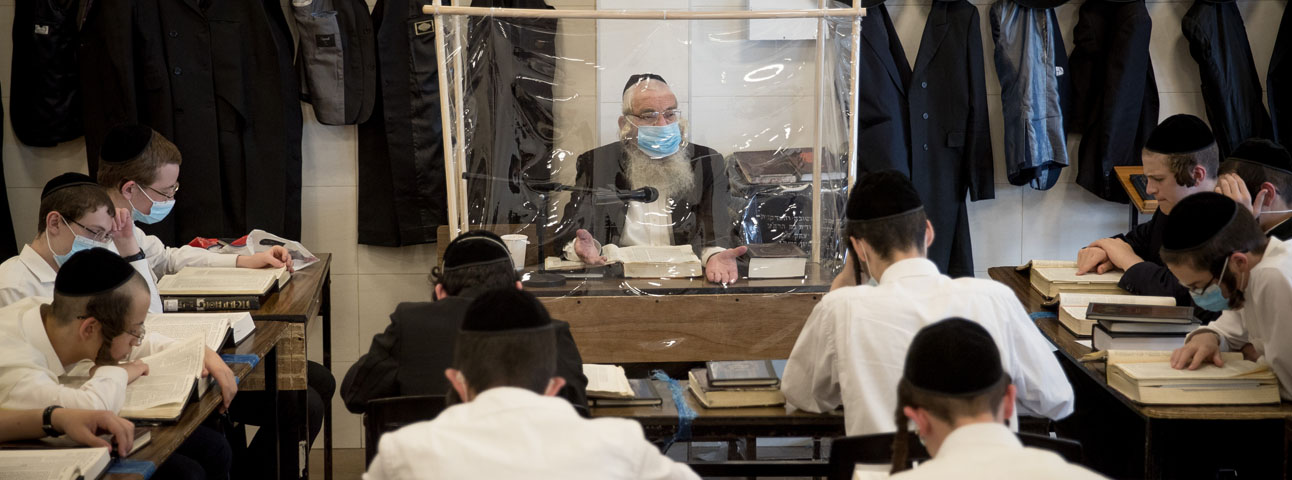The Haredi Fears Behind the Opening of Yeshviot Amid COVID-19
For many, the spiritual and educational dangers inherent in leaving large numbers of young people with no binding religious framework outweigh the health risks in keeping these institutions open.

Flash 90
The stubborn insistence of the ultra-Orthodox spiritual and political leadership that yeshivot and religious educational institutions must keep their doors open, despite government restrictions (and even more seriously, despite the dangers posed by the spread of the coronavirus within their walls), is viewed by many as an irresponsible act, threatening the welfare not only of the ultra-Orthodox community but of Israeli society as a whole. As is well known, the ultra-Orthodox community attributes supreme significance to Torah study, and views the Torah as the cornerstone of the continued existence of the Jewish people. However, a closer look reveals that there is an additional consideration comes into play, one no less significant—the very real fear of ultra-Orthodox leadership that many ultra-Orthodox youth who are already on the margins of ultra-Orthodox society, may be lost to the community.
This is not a new phenomenon. These youth are part of a growing trend of marginalization and dropout among ultra-Orthodox youth, which has only gained momentum since the outbreak of the pandemic. The “junior yeshivot” ,” in which the vast majority of ultra-Orthodox boys of high-school age study, are the community’s cultural and social fortress, , on the cutting edge of its religious, social, and cultural life.
According to Ministry of Education data, rates of overt, reported dropout from ultra-Orthodox schools under Ministry supervision reached 4.6% in 2018, three times the rate in the State education stream (just 1.4%). If this wasn’t troubling enough, education experts believe that there is a much larger rate of “hidden dropout”; researchers have estimated that close to 20% of students in “junior yeshivot” attend school only sporadically and are on the verge of dropping out.
There are many reasons for these high dropout rates, including: financial difficulties; learning disabilities undiagnosed at a young age; lack of tools and experience among ultra-Orthodox educators when it comes to helping struggling students; difficulties in adjusting to a demanding and uniform curriculum , in which you can study any subject you like—that is, as long as it is Talmud; gaps in religious faith between parents and children; the effects of the digital age resulting in the growing exposure of youth to contents and norms that are offensive to the ultra-Orthodox world, and more.
Ultra-Orthodox society is fully aware of the formidable challenge that the growing numbers of marginal youth pose to its education system-the very foundation on which the community is built. And so, the ultra-Orthodox community is prepared to make every effort to maintain normalcy and a regular study routine in yeshivot, even at the cost of the spread of the virus throughout ultra-Orthodox population centers. For many in the community, the spiritual and educational dangers inherent in leaving large numbers of young people with no binding religious framework, and thus being more likely to stray from the path, outweigh the health risks in keeping these institutions open.
This is also the reason why, in recent years, educational alternatives are being created for ultra-Orthodox youths who are not interested in or are incapable of full-time Torah study in yeshivot. These alternatives—which include ultra-Orthodox yeshiva high schools that include core curriculum, vocational high schools, yeshivot in which Torah study is less demanding, and institutions for at-risk ultra-Orthodox youth—offer an additional protective shield to keep these young people within the community, by providing them with a curriculum combining religious and secular studies. A comprehensive study published recently, indicates that in the previous school year (2019–2020), some 2,200 ultra-Orthodox boys attended ultra-Orthodox yeshiva high schools, compared with just 540 two decades ago. There has also been a significant rise in the number of technological educational frameworks in recent years, offering an alternative for ultra-Orthodox youth who struggle with Torah study and for those on the margins. At the same time, these frameworks are still facing substantial difficulties due-- at least in part-- to the fact that they lack legitimacy and support within ultra-Orthodox society, based on the very fact that they offer secular studies alongside religious studies.
It would be a mistake to think that dropout and marginalization among ultra-Orthodox youth is solely an internal problem of the ultra-Orthodox community. The State also has an interest in helping and supporting these young people, whose numbers are escalating, providing aid for the development of alternative educational frameworks can help stave off social detachment and alienation, which in turn-- often lead to extreme behavior, including crime and addiction. There is an urgent and immediate need to formulate a cautious, informed, and incremental plan for reopening the doors of yeshivot. If we fail to do so, we will see an increase in dropout rates in ultra-Orthodox society, for which we will all pay a price in the not-too-distant future.
The article was published in the Jerusalem Post.
